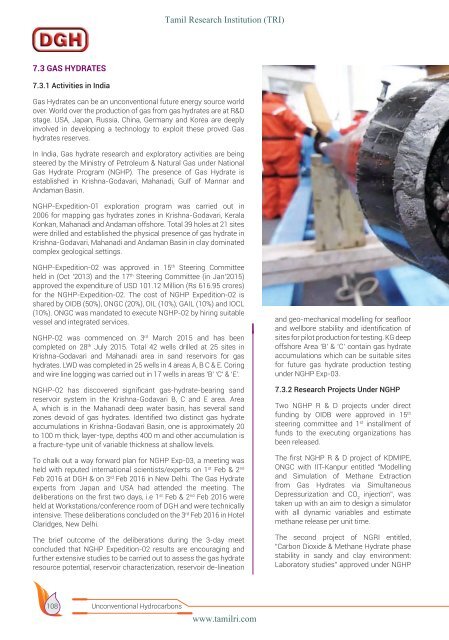HELP Hydrocarbon Exploration and Licensing Policy
You also want an ePaper? Increase the reach of your titles
YUMPU automatically turns print PDFs into web optimized ePapers that Google loves.
Tamil Research Institution (TRI)<br />
7.3 GAS HYDRATES<br />
7.3.1 Activities in India<br />
Gas Hydrates can be an unconventional future energy source world<br />
over. World over the production of gas from gas hydrates are at R&D<br />
stage. USA, Japan, Russia, China, Germany <strong>and</strong> Korea are deeply<br />
involved in developing a technology to exploit these proved Gas<br />
hydrates reserves.<br />
In India, Gas hydrate research <strong>and</strong> exploratory activities are being<br />
steered by the Ministry of Petroleum & Natural Gas under National<br />
Gas Hydrate Program (NGHP). The presence of Gas Hydrate is<br />
established in Krishna-Godavari, Mahanadi, Gulf of Mannar <strong>and</strong><br />
Andaman Basin.<br />
NGHP-Expedition-01 exploration program was carried out in<br />
2006 for mapping gas hydrates zones in Krishna-Godavari, Kerala<br />
Konkan, Mahanadi <strong>and</strong> Andaman offshore. Total 39 holes at 21 sites<br />
were drilled <strong>and</strong> established the physical presence of gas hydrate in<br />
Krishna-Godavari, Mahanadi <strong>and</strong> Andaman Basin in clay dominated<br />
complex geological settings.<br />
NGHP-Expedition-02 was approved in 15 th Steering Committee<br />
held in (Oct ’2013) <strong>and</strong> the 17 th Steering Committee (in Jan’2015)<br />
approved the expenditure of USD 101.12 Million (Rs 616.95 crores)<br />
for the NGHP-Expedition-02. The cost of NGHP Expedition-02 is<br />
shared by OIDB (50%), ONGC (20%), OIL (10%), GAIL (10%) <strong>and</strong> IOCL<br />
(10%). ONGC was m<strong>and</strong>ated to execute NGHP-02 by hiring suitable<br />
vessel <strong>and</strong> integrated services.<br />
NGHP-02 was commenced on 3 rd March 2015 <strong>and</strong> has been<br />
completed on 28 th July 2015. Total 42 wells drilled at 25 sites in<br />
Krishna-Godavari <strong>and</strong> Mahanadi area in s<strong>and</strong> reservoirs for gas<br />
hydrates. LWD was completed in 25 wells in 4 areas A, B C & E. Coring<br />
<strong>and</strong> wire line logging was carried out in 17 wells in areas ‘B’ ‘C’ & ‘E’.<br />
NGHP-02 has discovered significant gas-hydrate-bearing s<strong>and</strong><br />
reservoir system in the Krishna-Godavari B, C <strong>and</strong> E area. Area<br />
A, which is in the Mahanadi deep water basin, has several s<strong>and</strong><br />
zones devoid of gas hydrates. Identified two distinct gas hydrate<br />
accumulations in Krishna-Godavari Basin, one is approximately 20<br />
to 100 m thick, layer-type, depths 400 m <strong>and</strong> other accumulation is<br />
a fracture-type unit of variable thickness at shallow levels.<br />
To chalk out a way forward plan for NGHP Exp-03, a meeting was<br />
held with reputed international scientists/experts on 1 st Feb & 2 nd<br />
Feb 2016 at DGH & on 3 rd Feb 2016 in New Delhi. The Gas Hydrate<br />
experts from Japan <strong>and</strong> USA had attended the meeting. The<br />
deliberations on the first two days, i.e 1 st Feb & 2 nd Feb 2016 were<br />
held at Workstations/conference room of DGH <strong>and</strong> were technically<br />
intensive. These deliberations concluded on the 3 rd Feb 2016 in Hotel<br />
Claridges, New Delhi.<br />
The brief outcome of the deliberations during the 3-day meet<br />
concluded that NGHP Expedition-02 results are encouraging <strong>and</strong><br />
further extensive studies to be carried out to assess the gas hydrate<br />
resource potential, reservoir characterization, reservoir de-lineation<br />
<strong>and</strong> geo-mechanical modelling for seafloor<br />
<strong>and</strong> wellbore stability <strong>and</strong> identification of<br />
sites for pilot production for testing. KG deep<br />
offshore Area ‘B’ & ‘C’ contain gas hydrate<br />
accumulations which can be suitable sites<br />
for future gas hydrate production testing<br />
under NGHP Exp-03.<br />
7.3.2 Research Projects Under NGHP<br />
Two NGHP R & D projects under direct<br />
funding by OIDB were approved in 15 th<br />
steering committee <strong>and</strong> 1 st installment of<br />
funds to the executing organizations has<br />
been released.<br />
The first NGHP R & D project of KDMIPE,<br />
ONGC with IIT-Kanpur entitled “Modelling<br />
<strong>and</strong> Simulation of Methane Extraction<br />
from Gas Hydrates via Simultaneous<br />
Depressurization <strong>and</strong> CO 2<br />
injection”, was<br />
taken up with an aim to design a simulator<br />
with all dynamic variables <strong>and</strong> estimate<br />
methane release per unit time.<br />
The second project of NGRI entitled,<br />
“Carbon Dioxide & Methane Hydrate phase<br />
stability in s<strong>and</strong>y <strong>and</strong> clay environment:<br />
Laboratory studies” approved under NGHP<br />
108<br />
Unconventional <strong>Hydrocarbon</strong>s<br />
www.tamilri.com


















